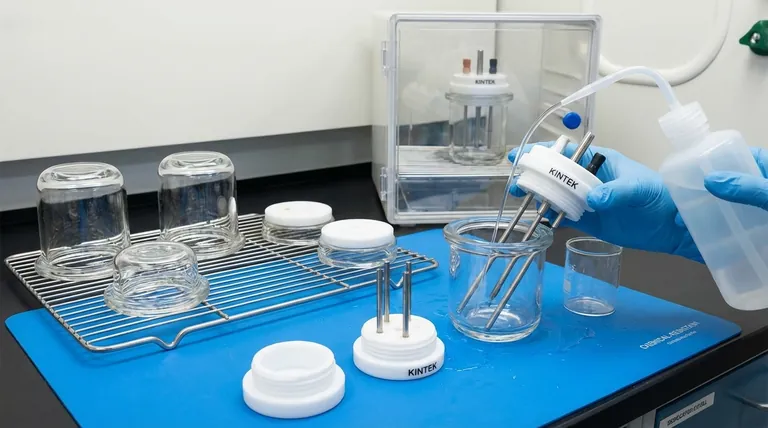Properly storing an electrolytic cell is crucial for ensuring its longevity and the accuracy of your future experiments. The fundamental procedure involves thoroughly cleaning and drying the electrodes and vessel, then storing them in a moisture-free environment. For extended periods of disuse, you must also remove the electrolyte and seal the cell.
The core principle of electrolytic cell storage is mitigating two primary risks: physical damage to its fragile components and chemical degradation from moisture and contamination. Your storage strategy must adapt based on how long the cell will be inactive.

The Core Principles of Cell Storage
To maintain the integrity of your equipment, three principles must guide your handling and storage process: physical safety, moisture elimination, and prevention of chemical contamination.
Prioritize Physical Safety
The body of an electrolytic cell is typically made of glass, a fragile material that requires careful handling.
Always hold the cell gently and securely to prevent accidental drops or impacts that could cause it to crack or shatter.
Eliminate Moisture
Moisture is the primary catalyst for the corrosion of electrodes and can introduce impurities that affect experimental results.
Every component, especially the electrodes and the reaction vessel, must be thoroughly dried before being put away.
Prevent Chemical Contamination
Residual chemicals or reaction byproducts from a previous experiment can compromise the validity of your next one.
Proper cleaning after each use is a non-negotiable step before storage. This ensures the cell is inert and ready for its next application.
Step-by-Step Storage Procedures
The correct procedure depends on whether you are storing the cell overnight or for several weeks or months.
For Short-Term Storage (Between Uses)
This method is suitable for daily or weekly use.
- Clean the Cell: After use, clean the electrodes and vessel to remove all reaction products. For noble metal electrodes like platinum, this may involve soaking them in a dilute acid (e.g., 1M nitric acid).
- Rinse Thoroughly: Rinse all components with deionized water to remove any residual cleaning agents or salts.
- Dry Completely: Ensure all parts are completely dry. Air drying or using a gentle stream of inert gas is effective.
- Store in a Dry Place: Place the assembled or disassembled cell in a clean, dry, and dust-free environment, such as a desiccator or a dedicated laboratory cabinet.
For Long-Term Storage (Weeks or Months)
When the cell will be inactive for an extended period, you must take extra steps to prevent degradation.
- Follow Short-Term Cleaning: Complete all cleaning, rinsing, and drying steps outlined above.
- Remove the Electrolyte: Drain the electrolyte from the cell completely. Store it separately in a properly labeled and sealed container if you intend to reuse it.
- Seal the Cell: Seal the empty cell's openings with stoppers or Parafilm. This prevents atmospheric moisture and dust from entering and settling on the internal surfaces.
- Store Securely: Place the sealed, empty cell in a secure location where it will not be disturbed or damaged.
Common Pitfalls to Avoid
Mistakes in storage can be costly, leading to damaged equipment and unreliable data.
The Risk of Improper Drying
Even small amounts of residual moisture can cause slow-developing corrosion on electrode surfaces. This damage alters the electrode's electrochemical properties and leads to inaccurate measurements.
The Danger of Contamination
Failing to clean the cell thoroughly or rinsing with tap water instead of deionized water can leave behind a film of chemical residue. These contaminants can interfere with or catalyze unintended side reactions in your next experiment.
Forgetting Electrode-Specific Needs
Different electrode materials have unique vulnerabilities. For example, some metal electrodes are highly prone to oxidation and may require special storage, such as immersion in a protective antioxidant solution or being kept in a dry, oxygen-free environment like a nitrogen box.
Making the Right Choice for Your Goal
Your storage protocol should directly reflect your usage pattern and the sensitivity of your equipment.
- If your primary focus is frequent use (daily/weekly): Concentrate on a rigorous post-use cleaning and drying routine before placing the cell in a designated dry storage location.
- If your primary focus is long-term preservation: You must empty the electrolyte and seal the cleaned, dried cell to protect it from the environment.
- If your primary focus is high-precision measurement: Always consider the specific material of your electrodes and consult manufacturer guidelines for any specialized storage needs to prevent oxidation or degradation.
Proper storage is an investment in the reliability of your data and the operational life of your equipment.
Summary Table:
| Storage Duration | Key Steps | Primary Goal |
|---|---|---|
| Short-Term (Daily/Weekly) | Clean, rinse with deionized water, dry completely, store in a dry place. | Ready for frequent, repeated use. |
| Long-Term (Weeks/Months) | Clean and dry thoroughly, remove electrolyte, seal openings, store securely. | Prevent degradation during extended disuse. |
Ensure your experiments are built on a foundation of reliable equipment. Proper storage is just one part of maintaining your lab's precision. KINTEK specializes in high-quality lab equipment and consumables, providing the durable electrolytic cells and supplies your laboratory needs for accurate, repeatable results.
Contact KINTEK today to discuss your specific laboratory requirements and discover how our solutions can support your research integrity.
Visual Guide

Related Products
- Electrolytic Electrochemical Cell with Five-Port
- Double Layer Five-Port Water Bath Electrolytic Electrochemical Cell
- Quartz Electrolytic Electrochemical Cell for Electrochemical Experiments
- Double-Layer Water Bath Electrolytic Electrochemical Cell
- Electrolytic Electrochemical Cell for Coating Evaluation
People Also Ask
- What are the standard components of the five-port water bath electrolytic cell? Master the Precision Instrument for Electrochemical Analysis
- How can contamination be avoided during experiments with the five-port water bath electrolytic cell? Master the 3-Pillar Protocol
- How should the five-port water bath electrolytic cell be cleaned for maintenance? A Step-by-Step Guide to Reliable Results
- How should the body of an electrolytic cell be maintained for longevity? Extend Your Equipment's Lifespan
- How should the five-port water bath electrolytic cell be operated during an experiment? Master Precise Control for Reliable Results



















